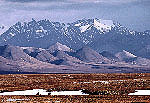Perhaps we should be amazed that America’s largest protected area — the 19.2 million-acre Arctic National Wildlife Refuge (ANWR) — has remained inviolate this long. Politicians from U.S. energy-producing states and the fossil fuel lobby have been trying to open the area for drilling since the United States Geological Survey first posited significant reserves there in the 1980s. Despite continuous pressure, however, ANWR has remained off limits, mostly because enough members of Congress have accepted the argument that the caribou, musk ox, polar bear, and other fauna and flora of the fragile coastal plain would be threatened by development.


Now, with oil at $140 a barrel and gas more than $4.00 a gallon, talking heads once again fill the U.S. airwaves with sneers about the absurdity of keeping ANWR off-limits because of bleeding-heart environmentalists who put caribou over people. President Bush has ratcheted up the political pressure, demanding that Democrats agree not only to open ANWR, but also to end a 26-year congressional ban on drilling for oil and gas off the east and west coasts of the United States. The president asked that the drilling bans on the outer continental shelf and in ANWR be lifted before Congress adjourns for summer recess — an unlikely scenario, but one that illustrates how politically sensitive the issue of high energy prices has become.
The arguments for drilling haven’t changed since I visited ANWR 19 years ago, but the stakes have skyrocketed. As the pressures to find new supplies of oil mount, the fate of ANWR has grown from being a symbolic mirror of American values into a test of the conviction with which those values are held. The object of this battle is an Austria-sized swath of mountains, coastal plain, and tundra bordering the Arctic Ocean in northeastern Alaska. It was easier to protect this wilderness for the sake of wildlife and future generations when the conventional wisdom assumed that increased demand for oil would always be matched by new discoveries somewhere else.
Now, with ominous signs that global oil production has begun to stall, this test has gotten a lot harder. It’s a test with two questions: Is there anything we Americans won’t sacrifice to feed our lust for oil? And will the future history of the rise and fall of the American dream simply be a story of the discovery and exploitation of oil?
There’s little dispute that ANWR contains significant oil reserves, though how much is subject to debate. (Optimistic estimates project that peak ANWR production will be roughly 800,000 barrels per day in about 20 years.) What is indisputable is that opening ANWR will not reverse America’s dependence on imports — at maximum production, ANWR will produce less than 7 percent of what the U.S. currently imports each day, and that high level of output would last only about a dozen years. Domestic oil production peaked in 1970 in the United States and has been on a steady decline for decades. Opening ANWR and other vulnerable areas on the continental shelf might slightly delay our increasing dependence on foreign supplies, but such actions will not reverse the decline. Thus we face a choice: We can shift to alternatives to fossil fuels while some vestiges of America’s wildlands remain intact, or we can do the same thing after every corner of the landscape has been marked by drilling and mining.
It didn’t have to be this way, which brings us to test question number two. Given oil’s utter dominance in the global economy, it’s easy to forget that little more than a century ago it was just one of several forms of energy competing for attention. In the late 19th century, the worry was peak coal, not peak oil, and tinkerers explored ways to capture solar, wind, tidal, wave, and other forms of alternative energy, many of them similar in design and form to 21st-century projects being touted as visionary today.
For instance, John Perlin, the author of From Space to Earth: the Story of Solar Electricity, notes that a present-day 400-megawatt solar power plant in the Mojave Desert uses the same basic principles as a plant built in Egypt in 1912 and 1913 by an engineer named Frank Shuman. Most of these early ventures fell prey to a liquid fossil fuel that came to mesmerize the public, so much so that people began to equate oil with energy. The very phrase “alternative energy” implies that anything other than fossil fuels is marginal.
Now, a century later, the United States is slowly awakening from this century-long trance and engineers and entrepreneurs are once again looking covetously at the power of the sun and seas. Unfortunately, the century of missed opportunities comes with a price. The readily deployable alternatives — notably wind and solar energy — will have to grow many times faster than they’ve ever grown simply to keep up with the increased demand for energy, much less make up for declining domestic production or declining oil available on the export market. The goal is a stretch, but achieving it would happily put to rest the question of whether the key to American prosperity was ingenuity or oil.
Achieving that goal would also take the pressure off ANWR and other remaining wild places. Through their votes and wallets, Americans have demonstrated that they value conservation and environmental protection. But, just as fears about security have tested our commitment to the Bill of Rights, concerns about energy challenge the depth of our convictions when it comes to the environment. Let’s hope we’ll do better on this new test.